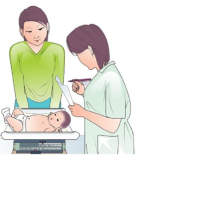
What is growth monitoring and promotion?
Many children under five years of age who live in low‐ and middle‐income countries are not receiving adequate nutrition. This can lead to increased illnesses, impaired mental development (which diminishes school and work performance later in life) and death. Growth monitoring and promotion (GMP) is a complex intervention that involves measuring a child's growth at regular intervals and plotting the measurements on a chart, combined with different nutrition promotion activities. However, there are no standard guidelines explaining how to implement GMP or how to design the promotion activities, and even the purpose of GMP remains unclear.
What did we want to find out?
We aimed to assess the effectiveness of child GMP for identifying and addressing slow growth, improving infant and child feeding practices, and promoting contact with and use of health services in children under five years of age in low‐ and middle‐income countries.
What did we do?
We searched different databases that contain both published and unpublished results. We included randomised controlled trials (where investigators randomly allocate participants to different treatment groups); controlled before‐after studies (where investigators measure results in different treatment groups before and after the intervention to see whether they have changed); and cohort studies (where investigators monitor people with and without a particular exposure over time; in this case the exposure would be GMP). We combined the results narratively to provide an overview of the findings.
What did we find?
We included six studies. They were conducted in resource‐poor rural settings with high levels of malnutrition. We grouped the findings according to the type of intervention, which varied across studies.
Key results
There is limited and uncertain evidence on the effectiveness of GMP.
GMP programmes delivered in community health centres and meeting spaces compared to standard care
Three studies assessed the impact of a GMP programme delivered in community health centres and meeting spaces compared to standard care.
When looking at infant and child feeding practices at 24 months, we are unsure if GMP has any impact on the percentage of infants who had fluids other than breast milk introduced early (this was the case for 49.7% of infants in the GMP group and 70.5% of infants in the control group in one study). When looking at health service usage at 24 months, we are unsure if GMP has any impact on the percentage of children who receive vitamin A (72.5% of the GMP group and 62.9% of the control group in one study), or on the percentage of children who receive deworming (29.2% of the GMP group and 14.6% of the control group in one study). No studies reported child growth at 12 or 24 months, infant and child feeding practices at 12 months, or health service usage at 12 months.
GMP programmes delivered in community health centres and meeting spaces, providing extra food to children, compared to standard care
Two studies assessed the impact of a GMP programme delivered in community health centres and meeting spaces, providing extra food to children, compared to standard care.
When looking at infant and child growth at 12 months, we are unsure if GMP makes any difference to average weight‐for‐age (one study), and GMP may make little or no difference to the average height‐for‐age (one study). Two studies reported a range of outcome measures related to infant and child feeding practices at 12 months, and we are unsure if GMP had any impact. No studies reported health service usage at 12 or 24 months, feeding practices at 24 months, or infant and child growth at 24 months.
What are the limitations of the evidence?
We are not confident in the evidence because we have serious concerns about the reliability of the reported results. This is because in all studies, it is likely that the participants were aware of which treatment their village had been assigned to before they chose to participate. Findings should be interpreted with caution.
How up to date is this evidence?
The evidence is current to 3 November 2022.
- Taylor M, Tapkigen J, Ali I, Liu Q, Long Q, Nabwera H. The impact of growth monitoring and promotion on health indicators in children under five years of age in low‐ and middle‐income countries. Cochrane Database of Systematic Reviews 2023, Issue 10. Art. No.: CD014785. DOI: 10.1002/14651858.CD014785.pub2
Access the full-text open access review here.
Note: this Cochrane Review supersedes the published Cochrane Review Panpanich 1999.
